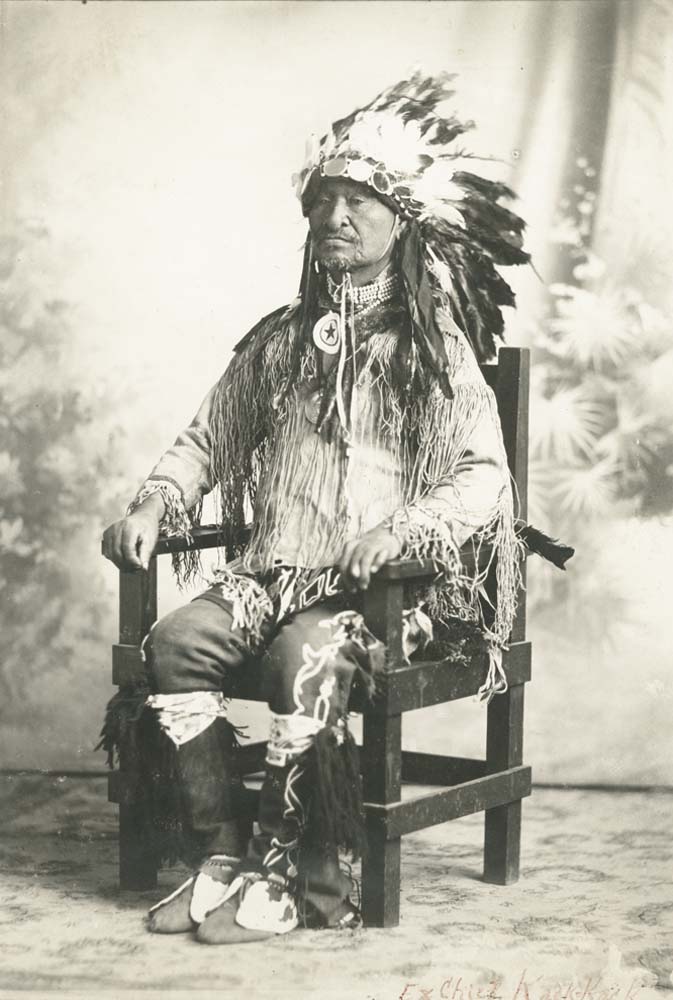

![]()

Kack Kack, a respected Prairie Band Potawatomi Chief and Warrior
![]()
Potawatomis vs. The Pawnee in Kansas
In early 1834, the Pawnees had agreed to retire beyond the platte. They seem to have been possessed of a determination to hold the value of the Kansas River. No sooner had the Potawatomis settled themselves at the mission of St. Mary’s than the Pawnees began the attacks upon them, intending to expel them or at least hoping to make the new home so uncomfortable the Potawatomi would abandon it. But the old Algonquin stock was ever courageous. The Potawatomi accepted the challenge. They declared war on the Pawnees and dug up the tomahawks. The Pawnee force was camped along the Big Blue, down which stream they always came to make war on the enemies in the valley of the Kansas. The Potawatomi attacked at the Rocky Ford at what is now the Potawatomi County. A fierce skirmish ensued, in which the Superior Firearms of the Potawatomi gave them the advantage. While the Pawnees were not defeated, they did retreat from the field, passing westward to Chapman’s Creek, where they made a stand. There they had a better country for the free movements of their horses, in their peculiar tactics. The Potawatomi pursued, and when they came up with their foes a considerable battle ensued. The Pawnees had only horsemen and at the Rocky Ford only mounted Potawatomis had engaged them. The Potawatomis were determined to settle once and for all whether they could live on the Kansas, and had mustered their full strength, many on foot. These later were stationed in some short bushy ravines under a high steep bank. The Potawatomi horsemen so maneuvered that the Pawnees were drawn down the prairie along these gullies when the Potawatomi footmen lying in ambush there opened fire.
The Pawnees were taken by complete surprise. Several of their foremost warriors were slain. But they did not give up the battle, which was fiercely contested with the mounted Potawatomi who were now much encouraged. They charged the Pawnees repeatedly, finally putting them to flight. The Pawnees disappeared northward over the prairies and never more made a foray below the Big Blue. The Potawatomis were never more molested by them. They lost some 40 warriors in this effort to drive out the Potawatomi. For many years a Potawatomi chieftain, who had distinguished himself greatly in this campaign, would decorate himself in true warrior style on the anniversary of the battle and ride to the western and northern boundary lines of the reserve to celebrate the victory and satisfy himself that their frontier was clear.
Prairie Band and Mission/Citizen Band
The
Potawatomi made a treaty in 1861 to dispose of the greater portion of their
reservation. There was a disagreement in the tribe on the subject of land. The
Prairie Band refused to accept their
land in severalty, and severed their relations with the other bands. They were
given a reservation in common eleven miles square in Jackson County, Kansas, a
part of the old home tract, and now reside upon it. It was provide that the
other bands should or might become citizens of the United States and have their
lands allotted to them. There was a surplus after the allotment and this went
through the usual process of graft in the final extinction of the Indian title.
In 1867 the Citizen Potawatomi secured
a reservation in what is now Shawnee, Oklahoma, where they moved and still live
today.